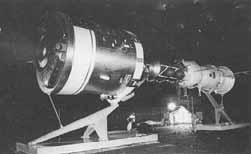
The 1973 Paris Air Show
According to Aviation Week and Space Technology, a full-scale representation of the Apollo command and service module (CSM) and docking module joined with a Soyuz spacecraft formed the "focal point for the 30th Paris Air Show" held on 25 May to 3 June 1973.8 The Soviets and Americans, represented by Igor Gregoryevich Pochitalin and Charles A. Biggs, had decided at the December 1972 Moscow negotiations to prepare an exhibit that would show the aerospace world the progress made toward the joint flight.9 Although plans for the display came too late for the show management to provide space in one of the permanent pavilions, they agreed to set aside some land usually reserved for parking on which the two teams [250] could erect a temporary fabric dome suspended from a geodesic frame. Inside the 930 square meters, NASA planned to display a refurbished CSM that had been used in vibration tests, and the Soviets would assemble a Soyuz from leftover test hardware.10

Soviet and American workers took five days to put together the dome and mate the spacecraft. American co-director Biggs quipped to an Aviation Week writer that he hoped the ASTP crews would get the job done a lot faster when they met in orbit. Pochitalin estimated that 2,000 to 3,000 people a day would visit the exhibit to see the mockups and the captioned photographs explaining the project in English, French, and Russian.11 To help publicize the presentation, cosmonauts Leonov, Kubasov, Filipchenko, and Yeliseyev met with the Apollo 17 crew - Cernan, Evans, and Schmitt - and their ASTP crewmate Tom Stafford. Brand and Slayton were unable to leave Houston because they were involved in the first manned visit to Skylab. Stafford and Leonov managed to fill in for the missing astronauts, posing for photographers and answering questions from the media and visiting dignitaries.
The ASTP exhibit in France was well received by the public until the very last hours it was open. The joint pavilion, the first exhibit to be seen upon entering the show grounds, stood in stark contrast to the military and commercial rivalry involved in other displays. In an editorial, Aviation Week's Robert Hotz indicated that the dramatic Apollo-Soyuz "docking display" was a symbolic expression of growing cooperation in space. A happy and friendly event, the Paris presentation attracted 400,000 visitors, surpassing the unexpected attendance thirteen times. The camaraderie displayed by the cosmonauts and astronauts was a welcome sign; they had not always been so close.12
8. "Apollo/Soyuz Spotlighting Cooperation at Paris Air Show," Aviation Week & Space Technology, 28 May 1973, p. 14; and Shirley Malloy to George M. Low, 25 May 1973, message relaying comment from Aviation Week editor Robert Hotz: "Your Paris exhibit is the star of the show."
9. "Minutes of Discussion on Organization of Joint Exhibition at the 30th International Aviation and Space in Paris, May 1973," 14-15 Dec. 1972.
10. Letter, Glynn S. Lunney to Konstantin Davydovich Bushuyev, 20 Feb.1973, with enclosure "Minutes of Paris Air Show Telephone Conversation, February 8, 1973."
11. "Apollo/Soyuz Spotlighting Cooperation at Paris Air Show," Aviation Week & Space Technology, 28 May 1973, p. 15.
12. Hotz, "Paris Vintage
1973," Aviation Week & Space
Technology, 11 June 1973 p. 7; and
interview, Charles A. Biggs-Edward C. Ezell, 28 Oct. 1975.
Next